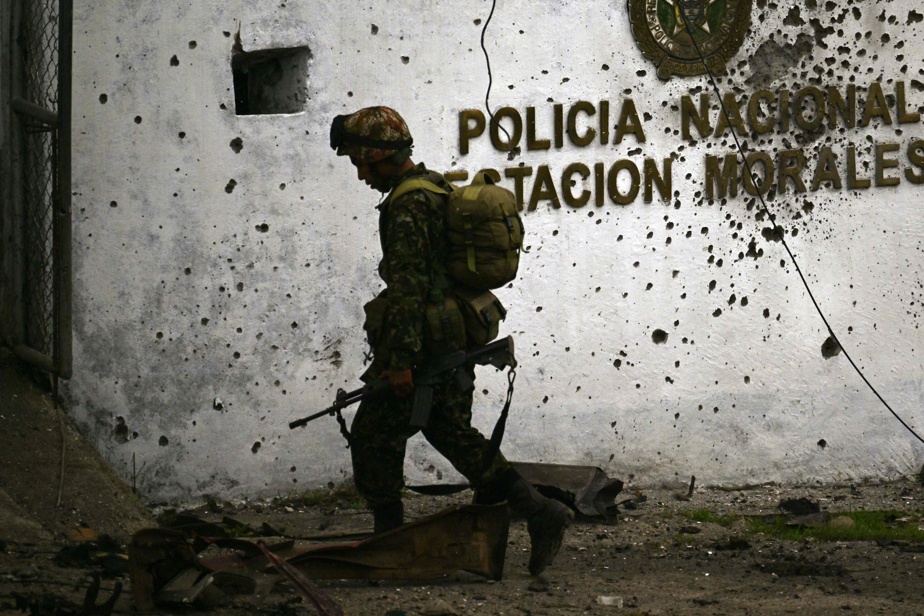(Bogotá) From the sky, the camera shows a dirt road winding through the green mountain. The drone releases its payload which explodes on contact with the ground.
The Colombian army recently released two videos of drone attacks carried out by armed groups, and there is no longer any doubt: the drone war has reached Colombia.
The method is unprecedented and worrying in a country theater of an internal armed conflict which has lasted for six decades between the State and the guerrillas against a backdrop of deep socio-economic inequalities.
According to the national press, citing military sources, at least 16 drone attacks against the army were recorded between the beginning of May and mid-June in the departments of the southwest of the country, Valle del Cauca, Cauca and Nariño.
No deaths have been reported so far. “We have fortunately, thanks to God, anticipated these attack attempts and we continue to improve our tactical and technical capabilities to counter this threat,” the commander of the armed forces, General Helder Giraldo, recently said in the media.
“Drones of Death”
The press, alarmed by these “drones of death”, published photos of a wounded man with a back pockmarked with shrapnel and of fighters busy tinkering with these new kinds of weapons, which the EMC would have in particular, main faction of the dissidence of the former FARC guerrillas.
“Commercial drones equipped with explosives have become a common tactic for armed groups, particularly in the southwest,” noted the think tank La Silla Vacia in an article at the end of May.
A weapon particularly well suited to the rugged Colombian terrain, the drone offers inexpensive technology, with a proven destructive capacity and a powerful psychological impact.
For the moment, these weapons are reduced to a DIY craft: a grenade or a mortar shell attached to the drone and dropped vertically over the objective. The war in Ukraine, however, demonstrated the deadly capacity of these devices, which changed the dynamics of the conflict there.

PHOTO RAUL ARBOLEDA, AGENCE FRANCE-PRESSE
Military police patrol the streets of Bogota
For La Silla Vacia, who quotes a former army commander, General Alberto Mejia, “the emergence of commercial drones tinkered with to be adapted to war is part of the tradition of these armed groups to compensate for the lack of conventional weapons.
“Artisanal, but effective”
“It’s a homemade technology, but it ends up being effective,” Luis Armas, a specialist in the security and use of these devices, explains to AFP.
According to the Cambio news site, “military intelligence services have discovered that over the past six months, courses on the use of drones […] were organized in different camps” of the ex-FARC dissidence as part of a “secret strategy”.
AFP obtained from official sources transcripts of intercepted telephone calls between members of the EMC, where they discuss their drone attack plans and their training in their use.
In one of these calls, the possibility of an attack with an “unmanned aerial vehicle” targeting the “neighborhoods of Bogota where the oligarchy hangs out” is even mentioned.
In April, General Giraldo ordered his men to “establish protocols and preventive measures” to “mitigate” the risk of drone attacks, according to a document leaked to the press.

PHOTO JUAN B DIAZ, ASSOCIATED PRESS
A police officer walks outside a police station after an attack in Morales, May 20, 2024. Police say two officers died in the attack carried out by dissidents from the Revolutionary Armed Forces of Colombia ( FARC), known as EMC.
Although there is little film footage of these devices, a rebel commander in the southwest of the country confirmed to AFP that their adoption was underway. “If the enemy prepares […] with drones, of course we need to see how we can upgrade.”
While hundreds of Colombian mercenaries are fighting today on both sides in Ukraine, a subsidiary question arises: could this know-how have been exported to Colombia via Marxist guerrilla fighters with claimed connections with the Russian bloc? ?
Better armed
In Popayan, capital of Cauca, the town hall banned drone flights following a bomb attack on a police station on June 7.
Last week, a charge dropped from a drone near a hospital in the municipality of Suarez exploded and injured a young girl. Another attack injured three soldiers with shrapnel in Argelia, in the same region, a stronghold of dissidence.
“The armed groups demonstrate that they are better armed, that they have better technology,” said Miller Hurtado, Secretary of Security of Cauca, worried about the lack of precision of these devices, with the obvious risk that they fall near civilian buildings or schools.
For Jorge Restrepo, researcher at the Resource Center for Conflict Analysis, the widespread use of drones by rebels “would mean a huge leap in military capacity” on the part of these groups.
It is an instrument “essentially intended for terrorism” and for which “the armed forces are not prepared”, he analyzes.
“We need to increase our capabilities,” Defense Minister Ivan Velasquez conceded on Tuesday. The head of the army, for his part, announced the opening of a “process of acquiring this type of unmanned aircraft as a tool to contain these terrorist actions”.
